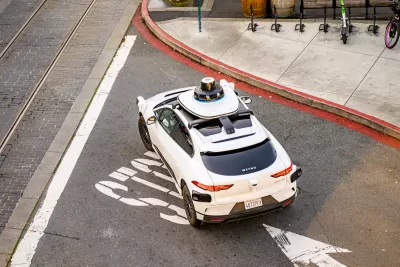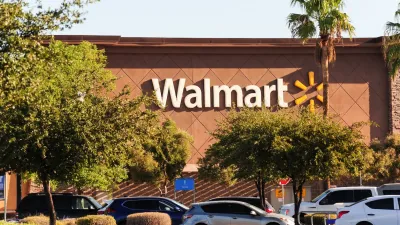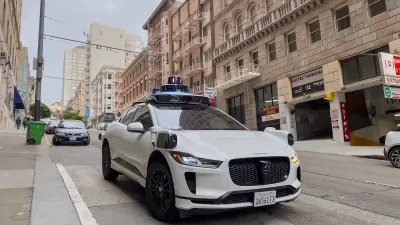In cities across the United States, robotaxis, championed by companies like Waymo and Cruise, are a marvel of modern technology and a flashpoint for debate over their place in urban transit.

“Robotaxis appeared with promises of safety, accessibility, and environmental benefits. The appeal is clear: driverless taxis eliminate the need for human drivers, theoretically reducing human error in accidents and lowering transportation costs for the public.” But as an article in Cities of the Future explains and Planetizen has chronicled, their impact on the rest of the transportation system and urban infrastructure becomes more evident.
Waymo, for example, touts its extensive safety protocols, with each vehicle equipped with a suite of sensors, including lidar, radar, and cameras that can operate with higher precision than human vision. Early data seems to indicate that, in controlled environments, robotaxis have lower accident rates than human-driven cars, but high-profile crashes involving autonomous cars have created an atmosphere of mistrust.
“The rollout could have been smoother. Cities like San Francisco have already seen issues with these vehicles interacting poorly with emergency services and blocking public transit lanes, causing frustration among officials and residents. Incidents in which AVs halt suddenly in traffic or interfere with emergency responders highlight concerns about their readiness for the unpredictable nature of urban driving. In response, some residents have attempted to disable AVs by placing traffic cones on their hoods, expressing a belief that these vehicles may worsen, rather than improve, traffic congestion and public safety.”
FULL STORY: Robotaxis Wreak Havoc on Urban Transit

Rethinking Redlining
For decades we have blamed 100-year-old maps for the patterns of spatial racial inequity that persist in American cities today. An esteemed researcher says: we’ve got it all wrong.

Planetizen Federal Action Tracker
A weekly monitor of how Trump’s orders and actions are impacting planners and planning in America.

Walmart Announces Nationwide EV Charging Network
The company plans to install electric car chargers at most of its stores by 2030.

EPA Awards $267 Million to Clean Up and Reuse Contaminated Sites
The EPA is investing the funds to clean up and redevelop contaminated sites nationwide, supporting economic growth, community revitalization, and environmental restoration.

Knoxville Dedicates $1M to New Greenway
The proposed greenway would run along North Broadway and connect to 125 miles of existing trails.

Philadelphia Launches ‘Speed Slots’ Traffic Calming Pilot
The project focuses on a 1.4-mile stretch of Lincoln Drive where cars frequently drive above the posted speed limit.
Urban Design for Planners 1: Software Tools
This six-course series explores essential urban design concepts using open source software and equips planners with the tools they need to participate fully in the urban design process.
Planning for Universal Design
Learn the tools for implementing Universal Design in planning regulations.
City of Moorpark
City of Tustin
City of Camden Redevelopment Agency
City of Astoria
Transportation Research & Education Center (TREC) at Portland State University
Regional Transportation Commission of Southern Nevada
Toledo-Lucas County Plan Commissions





























